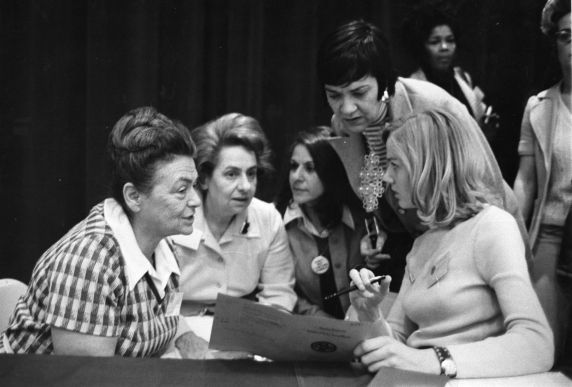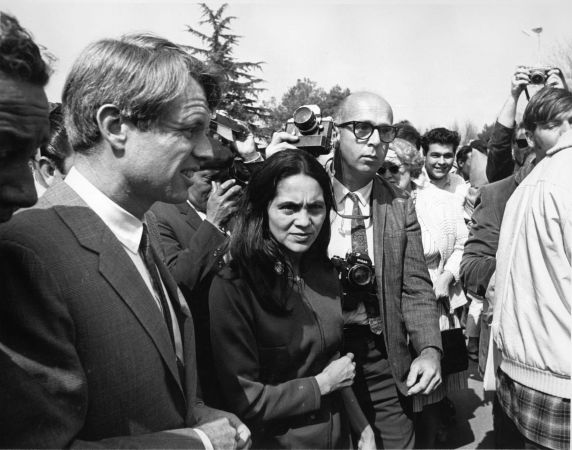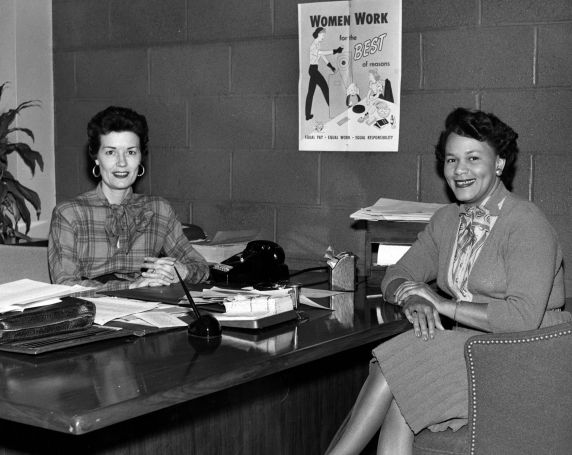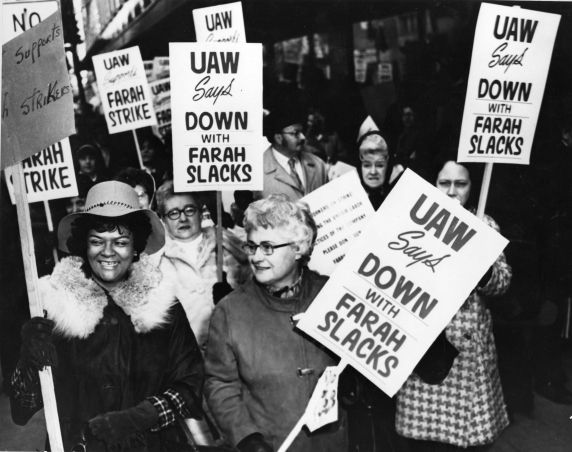Subject Focus: Women in Labor Unions
- Affirmative action
- AFSCME
- American Federation of Teachers
- Civil rights
- CLUW
- Coalition of Labor Union Women (U.S.)
- Equality
- Feldman, Sandra
- Feminism
- Flynn, Elizabeth Gurley
- Huerta, Dolores, 1930-
- Jeffrey, Mildred, 1911-2004
- Kraus, Dorothy
- Labor
- Labor movement
- Labor unions
- Madar, Olga M.
- Pay equity
- SEIU
- Subject focus
- UAW
- Wolfgang, Myra, 1914-1976
- Women
- Women employees
- Women in the labor movement
- Women's rights
- Workers' rights
- Working class women
“We didn’t come here to swap recipes!” Those words, uttered by Myra Wolfgang during the first Coalition of Labor Union Women (CLUW) convention in 1974 set the tone for an agenda aimed at increasing women’s involvement and influence in labor unions. Coming on the heels of landmark legislation such as the Equal Pay Act (1963), the Civil Rights Act (1964), and the Equal Employment Opportunities Act (1972), the formation of CLUW institutionalized the long-held ambitions of individual female union members to participate more fully in the labor movement. Their struggle to the top mirrors efforts made by all American working women as their numbers continued to swell the workforce and their domain was no longer limited to the household. The Equal Rights Amendment and affirmative action policies inspired countless women, including those in the labor movement, to ‘step up to the plate’. While women’s rights and issues of particular interest to women may have served as the impetus to many seeking leadership, they were not fought for in exclusivity. Alongside gender-specific aims, women sought to represent all workers, men or women of every race, in their shared effort for improved compensation, working conditions, and quality of life. Likewise, with close ties to the civil rights movement, women aspired to affect change outside of the workplace, from social activism to political action. It is difficult to examine any one these aims on its own as their interconnectivity is what makes women’s position in American unions a unique story.
The 1960s and 1970s marked the beginning of significant opportunities for union women that continue to build to this day with recent success stories like Mary Kay Henry, the first female president of the Service Employees International Union (SEIU). In fact, now, with the waning of many major unions, women leaders are being touted by some as labor’s best hope for continued relevancy. From reinvigorating rank and file workers to helping shape public sentiment, as in the case of National Nurses United and Occupy Wall Street, women continue to increase their profile in what still largely remains a male-dominated culture.
However noteworthy their recent upward mobility has been, women have long been active in the labor movement from the early days of trade unions, despite their frequent marginalization in American labor history. In the 19th century, women were routinely excluded from union membership and the idea of labor feminism was born, centering on some of the same issues women still advocate for, namely pay equity. While the American Federation of Labor (AFL) chartered women’s labor unions (separate from men’s) and the National Women’s Trade Union League became the first national body to organize women workers around the turn of the 20th century, it was difficult to maintain momentum when women remained in the vast minority of the labor workforce. Notwithstanding this climate, there were a few outstanding examples of early female leadership, like Elizabeth Gurley Flynn. A member of the International Workers of the World (IWW), Flynn became the first member of its general executive board and played a pivotal role in the 1912 Lawrence Textile Strike.
Women tended to make the greatest gains during wartime, as their numbers were needed to fill the gap left by men serving in the American Civil War and both World Wars. It was during wartime that unions, especially industrial unions, recruited more women members and took interest in their issues as both a way of appeasing the ‘temporary’ workforce and safeguarding matters like wage levels for returning war veterans. During the years between and after the World Wars women played crucial roles in organizing drives, forming women’s auxiliaries (mainly wives of male union workers) and contributing to the success of many sit-down strikes, both as workers and auxiliary members. Lillian Sherwood became president of the National Congress of Industrial Organizations (CIO) Women’s Auxiliary and as such was deeply involved in political and social activities on a local level. In the 1930s, Dorothy Kraus helped assist in Detroit-area UAW strikes such as the Flint Sit-Down, as the wife of union member Henry Kraus. Her efforts lead to the formation of the UAW Women’s Auxiliary. After all AFL-CIO unions admitted women at the end of WWII, women focused on the inadequacies of union contracts to address issues relevant to their status and opportunity in the workforce, such as day care and maternity leave.
By the 1960s and 1970s more women began to actively seek leadership roles, but their success often depended on the union in which they were members. It was still a numbers game. Unions with the most female membership included AFSCME, SEIU, and AFT. Occupational segregation largely dictated where women had the greatest effect and were able to rise to prominent positions — industries such as airlines, healthcare, public service, and education. Issues such as discrimination, sexual harassment, childcare, parental leave, flexible schedules, pay equity, and safety were paramount for women alongside issues that affected all union workers like wage scales, work hours, promotions, job training, and healthcare. Women also championed social issues such as patient care and quality education. There are countless examples of women leading the charge to defend these rights, such as those in SEIU District 925. Formed in 1981, 925 lobbied for pay equity, among other things. They were led by Karen Nussbaum, founder of 9 to 5, Jackie Ruff, Local 925 president, and later Debbie Schneider, former Ohio Regional Director and national organizing coordinator.
Dolores Huerta and Robert Kennedy face reporters on the day Cesar Chavez broke his fast in support of California farm workers.
In general, the path of women’s slow and steady progress in labor unions evolved from women’s auxiliaries to local and regional leadership and finally to nationally appointed or elected positions. These paths to recognition took different turns: those that founded unions, like Dolores Huerta, cofounder of the United Farm Workers; those that took the traditional route of working their way up from the shop floor; and more recently those that through expertise, worked their way up from professional staff employment. On into the 1970s – 1990s, women’s departments or committees were established in many major unions such as AFSCME, AFT, UAW, and SEIU encouraging female activism and providing an environment where women could more easily succeed. Marjorie Stern rose from secretary of the San Francisco Federation of Teachers Local 61 to chairwoman of the Women’s Rights Committee in 1971.
Many more women joined national staffs as organizers, especially in female-dominated fields, giving them necessary experience and visibility. Lillian Hatcher, UAW’s first African-American female international representative, served as an organizer in the national Women’s Department during the late 1950s – 1980s alongside it’s international representative at the time, Dorothy Haener. Women were also beginning to be elected in male-dominated positions such as vice-president and executive board member and given responsibilities such as legislation and public relations. Examples include Sandra Feldman, first female AFT president since 1930; Mildred Jeffrey, the UAW’s first female department head who, in succession, directed the Women’s Bureau, Community Relations Department and Consumer Affairs Department; Selma Borchardt, who served in various leadership roles in the AFT, such as vice president (1924-1962); and Olga Madar who was the first elected woman vice-president of the UAW.
Olga Madar, UAW Executive Board Member, supporting Farah boycott pickets around Hudson’s in Detroit.
Although improving, women’s inclusion in top leadership roles remained a small percentage as old gender-based stereotypes and obstacles to advancement, such as membership involvement and family obligations, lingered. Even though some women rose to national prominence, they were still more likely to achieve key local positions, with some unions reporting around 50% participation in local officers positions. Women like Edith Van Horn, the first woman to serve on UAW Local 3 Executive Board, made important inroads for women at the grassroots level.
Women’s History Month offers the opportunity to reflect on the part women have played at all levels in the labor movement in protecting women’s rights, advancing worker’s rights and affecting political and social change. Explore this aspect of women’s history by clicking on the links above to discover material in the archives on these remarkable women. The Reuther Library also holds personal accounts of many union women’s stories in its oral history collection. Search the Michigan Oral History database by name, affiliated union, or specific projects such as Detroit Area Feminists, Rosie the Riveter Revisited: Women and the World War II Work Experience, and Twentieth Century Trade Union Woman Vehicle for Social Change. Or, consult the list of all available oral histories including projects such as Metro Detroit Skilled Tradeswomen and SEIU: District 925 Legacy. Many photographs of women and their union activity can be found in the Reuther’s Image Gallery of the Labor Movement and Organizations, arranged by union. Publications, such as CLUW News, AFSCME’s Women’s Letter, or UAW’s Women’s Auxiliary News, among others, are also good resources. Conduct a search of the Reuther web site for “Women in the labor movement” to investigate further holdings.
Deborah Rice is the Technical Services Archivist for the Walter P. Reuther Library.
- drice's blog
- Login to post comments
- Printer-friendly version





 Reddit
Reddit Facebook
Facebook LinkedIn
LinkedIn